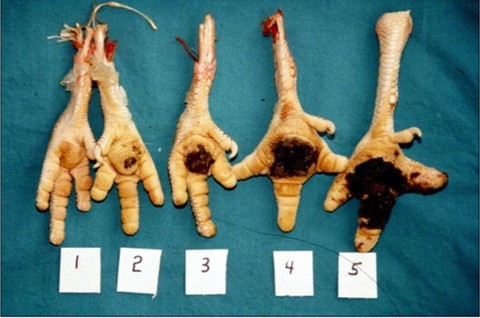Quick facts
- Footpad dermatitis appears as dark brown and black lesions on footpads of poultry.
- Managing litter moisture is key to preventing footpad dermatitis.
- Severe footpad dermatitis can negatively affect feed intake and feed conversion rate of turkey hens.
What is footpad dermatitis?
Footpad dermatitis (FPD) refers to inflamed and damaged skin on a bird’s footpad. Signs of FPD include thickened scales and dark brown and black lesions or ulcers on the footpads and toes of poultry.
Footpad dermatitis is a common problem in turkey production worldwide. Severe FPD lesions can reduce turkey performance by increasing feed intake and decreasing feed conversion ratio and body weight.
Causes
- Footpad dermatitis often results from litter that is over 30 percent moisture.
- Lesions can occur within 24 to 48 hours after contact with high moisture litter.
- Severe lesions can heal in 15 days after moving turkeys to dry litter.
- Other causes of FPD can include poor nutrition or disease.
Scoring footpad dermatitis
Scoring footpad dermatitis is key to monitoring animal welfare and managing the flock. Most turkey processing plants in the U.S. and organizations, such as National Turkey Federation or American Humane Farm Program, score footpad dermatitis on a 1 to 5 scale. A score of 1 refers to a healthy footpad with no lesions. A score of 5 refers to a footpad that has severe ulcers.
Know the footpad scores of your turkey flocks. The American Humane Farm Program recommends having 300 turkeys scored in the processing plant. Fewer than 30 turkeys should score a 3, 4 or 5 on the 5-point footpad scoring scale. Ask your processor if they keep records of footpad scores.
Preventing footpad dermatitis
- Check litter moisture on the floor every day. Wet litter may appear darker.
- Grab a handful of litter and squeeze it in your fist. If it crumbles easily, the moisture is likely low. If the litter compacts, the moisture is likely over 30 percent.
- Keep litter moisture low.
- Use heat and ventilation to remove excess moisture from turkey houses.
- Select bedding material that has a higher water holding capacity, such as pine. shavings, instead of straw or rice hulls.
- Check drinkers for leaks or other problems.
- Check the roof, floors, and sidewalls for any rain and water coming into the turkey house.
- Remove wet spots to limit the need to add bedding.
Research summary
We collaborated with Pennsylvania State University to study the effects of bedding source and stocking density on the performance and footpad health of turkey hens up to 14 weeks of age.
In a pen study, over 1000 turkey hens were kept on either pine shavings or Giant miscanthus grass. Stocking densities included 1.5, 2.0, or 2.5 hens per square foot at 14 weeks of age. We refer to these densities as low, medium, and high. Giant miscanthus grass is an alternative bedding material that farmers can grow in Minnesota and Canada. We scored footpads on a 3-point scale with a score of 0 meaning no lesions and 2 meaning severe lesions.
Turkey hen performance
Bedding sources did not affect body weight or feed conversion ratio at 14 weeks of age. But feed intake declined 4.65 percent for hens on Giant miscanthus grass compared to pine shavings during the final two weeks of production. This finding may be because of more severe footpad dermatitis seen at 14 weeks of age for hens kept on grass.
Turkey hens kept at a low stocking density had better performance than hens kept at a high density. Hens had 6.5 percent higher body weights at 14 weeks and 6.1 percent lower feed conversion ratio at low compared to high densities.
Footpad scores
We saw high litter moisture with grass bedding and high stocking density.
Bedding type and stocking density affected footpad scores of 14 week old turkeys. Pens averaged higher footpad scores for hens kept on grass compared to pine shavings.
The pen average for footpad scores was 1.43 for hens kept on grass and 0.71 for hens on pine shavings. Hens housed at low density had average footpad scores of 0.77 compared to 1.16 for medium and 1.27 for high densities.
Clark, Steven; Greg Hansen; Peter McLean; Paul Bond, Jr.; Wendy Wakeman; Roger Meadows; Silke Buda (October 1, 2002). Pododermatitis in Turkeys. Avian Dis. 46(4): 1038-1044 (2002) doi: https://doi.org/10.1637/0005-2086(2002)046[1038:PIT]2.0.CO;2
Reviewed in 2023


